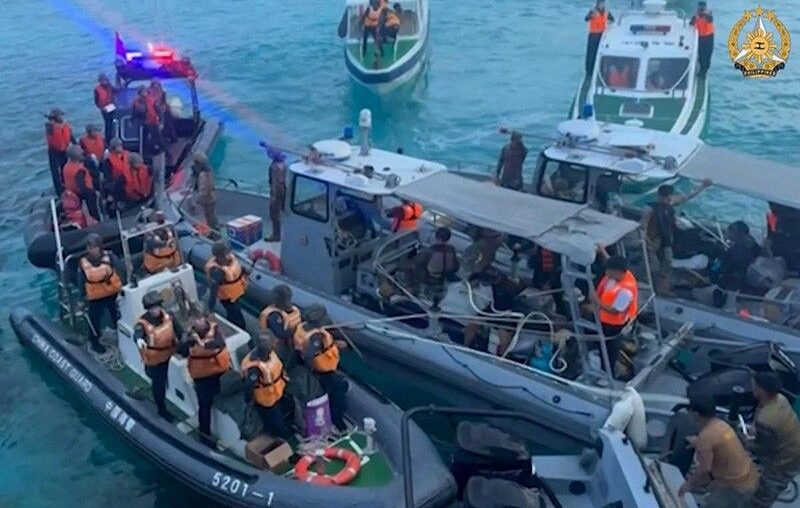November 21, 2024 | 1:03pm
MANILA, Philippines — The United States this week confirmed the existence of a dedicated military task force operating in support of Philippine interests at the hotly contested Ayungin Shoal.
The US Task Force Ayungin was established to enhance both nations’ coordination and enable American troops to support the Philippines’ military activities in the South China Sea, the US Embassy in Manila said Wednesday night, November 20.
The creation of a task force specifically focused on Ayungin Shoal — widely considered the most dangerous flashpoint of Beijing and Manila’s maritime tensions — marks a high level of direct US military commitment to a single disputed feature in the South China Sea.
Here’s what we know so far about the new task force.
Part of PH-US defense ties. The task force aligns with existing defense frameworks between the Philippines and the United States, including the Mutual Defense Board-Security Engagement Board process and Bantay Dagat, US Embassy Spokesperson Kanishka Gangopadhyay told reporters late Wednesday, November 20.
The Mutual Defense Board and Security Engagement Board is the principal mechanism that coordinates Philippine and US defense activities under their 1951 Mutual Defense Treaty. Under this, the Philippines and US militaries meet annually to discuss their defense and security cooperation.
The Bantay Dagat (Guardian of the Sea) framework, meanwhile, is a 2022 deal signed by the Philippines and US to improve maritime security in the region.
First disclosure. US Defense Secretary Lloyd Austin revealed the presence of “Task Force Ayungin” during his visit to Palawan on Tuesday, November 19, where he met with American service members deployed to the unit.
Austin bared the existence of the task force in a social media post thanking the US troops. He said: “I visited the Command and Control Fusion Center in Palawan today. I also met with some American service members deployed to US Task Force Ayungin, and I thanked them for their hard work on behalf of the American people and our alliances and partnerships in this region.”
Prior to this, Philippine defense officials had not mentioned the presence of a task force by US troops focused on the hotly contested feature.
After Austin’s X post, the US embassy confirmed the task force’s existence and briefly explained its role in supporting Philippine military activities in the disputed waters.
The task force is part of the US’ “long-standing shared efforts to address regional challenges, foster stability, and promote a free and open Indo-Pacific region,” Kanishka said.
What the Philippines has said. Col. Xerxes Trinidad, the public affairs chief of the Armed Forces of the Philippines, said the task force’s role is to provide technical assistance through the information-sharing group within the Command and Control Fusion Center in Western Command.
The military official told reporters late Wednesday: “This support enhances our capability in maritime domain awareness, a critical task that aids in planning and implementing programs and activities to protect our interests in the West Philippine Sea.”
Trinidad’s mention of enhancing the Philippines’ “maritime domain awareness” means the US task force is helping the Philippines have a clearer, more comprehensive picture of what’s happening in its waters.
Defense officials including the Philippine Navy spokesperson for the West Philippine Sea have repeatedly told reporters that it uses a range of methods to monitor Chinese vessels in the West Philippine Sea besides deploying its own fleet or patrol boats.
Philippine and US troops have long exchanged information about the South China Sea dispute, but this time, it is doing so with an eye on a single disputed feature in the South China Sea.
Why this matters
The Philippines’ BRP Sierra Madre has been grounded at Ayungin Shoal since 1999 and serves as the country’s outpost in the area.
The shoal, which lies 105 nautical miles west of Palawan, falls within the Philippines’ 200-mile exclusive economic zone. China claims the feature as part of its broader nine-dash line claim in the South China Sea.
Earlier this year, the Philippine Coast Guard reported several dangerous maneuvers by Chinese vessels attempting to block Philippine boats from reaching the BRP Sierra Madre. The most violent incident took place June 17 after Chinese vessels repeatedly rammed Philippine vessels to foil their resupply mission to BRP Sierra Madre. It left one Filipino sailor with a severed finger.
RELATED: Brawner presses China anew to pay P60 million for June 17 assault
Reacting to the incident, US Ambassador to the Philippines MaryKay Carlson condemned China’s actions and noted that it caused “bodily injury” towards Filipino personnel.
To de-escalate tensions, the Philippines and China met July 2 and reached a provisional arrangement over the Philippines’ resupply missions there.
Over a month later, the US government announced a whopping $500 million military aid package to boost the Philippines’ defense capabilities.

